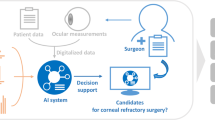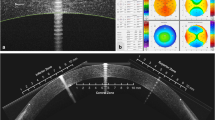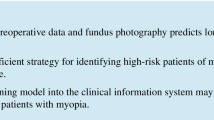Abstract
Purpose
To construct an automatic machine-learning derived algorithm discriminating between normal corneas and suspect irregular or keratoconic corneas.
Methods
A total of 8526 corneal tomography images of 4904 eyes obtained between November 2010 and July 2017 using a combined Scheimpflug/Placido tomographer were retrospectively evaluated. Each image was evaluated for acquisition quality and was labeled as normal, suspect irregular or keratoconic by a cornea specialist.
Two algorithms were built. The first was based on 94 instrument-derived output parameters, and the second integrated keratoconus prediction indices of the device with the 94 instrument-derived output parameters. Both models were compared with the tomographer’s keratoconus detection algorithms. Out of the 8526 images evaluated, 7104 images of 3787 eyes had sufficient acquisition quality. Of those, 5904 examinations were randomly chosen for construction of the models using the random forest algorithm. The models were then validated using the remaining 1200 examinations.
Results
Both RF algorithms had a larger AUC compared with any of the tomographer’s KC detection algorithms (p < 10–9). The first constructed model had 90.2% accuracy, sensitivity of 94.2%, and specificity of 89.6% (Youden 0.838). Calculated AUC was 0.964. The second model had 91.5% accuracy, sensitivity of 94.7%, and specificity of 89.8% (Youden 0.846). Calculated AUC was 0.969.
Conclusion
Using the RF machine-learning algorithm, accuracy of discrimination between normal, suspect irregular and keratoconic corneas approximates that of an experienced corneal expert. Applying machine learning to corneal tomography can facilitate keratoconus screening in large populations as well as off-site screening of refractive surgery candidates.






Similar content being viewed by others
References
Kamiya K, Ishii R, Shimizu K, Igarashi A (2014) Evaluation of corneal elevation, pachymetry and keratometry in keratoconic eyes with respect to the stage of Amsler-Krumeich classification. Br J Ophthalmol 98:459–463. https://doi.org/10.1136/bjophthalmol-2013-304132
Reeves SW, Ellwein LB, Kim T et al (2009) Keratoconus in the medicare population. Cornea 28:40–42. https://doi.org/10.1097/ICO.0b013e3181839b06
Hashemi H, Heydarian S, Yekta A et al (2018) High prevalence and familial aggregation of keratoconus in an Iranian rural population: a population-based study. Ophthalmic Physiol Opt 38:447–455. https://doi.org/10.1111/opo.12448
Merdler I, Hassidim A, Sorkin N et al (2015) Keratoconus and allergic diseases among Israeli adolescents between 2005 and 2013. Cornea 34:525–529. https://doi.org/10.1097/ICO.0000000000000416
Padmanabhan P, Rachapalle Reddi S, Sivakumar PD (2016) Topographic, tomographic, and aberrometric characteristics of post-LASIK Ectasia. Optom Vis Sci 93:1364–1370. https://doi.org/10.1097/OPX.0000000000000922
Gupta PK, Stinnett SS, Carlson AN (2012) Prevalence of sleep apnea in patients with keratoconus. Cornea 31:595–599
Lee HK, Jung EH, Cho B (2019) Epidemiological association between systemic diseases and keratoconus in a Korean population: a 10-year. Cornea 00:1–6. https://doi.org/10.1097/ICO.0000000000002206
Rabinowitz SY (1998) Major review. Surv Ophthalmol, 42.
Meiri Z, Keren S, Shenhav L, Varssano D (2016) Efficacy of corneal collagen cross-linking for the treatment of keratoconus: a systematic review and meta analysis. Cornea 35:417–428
Lin SR, Ladas JG, Bahadur GG et al (2019) A review of machine learning techniques for keratoconus detection and refractive surgery screening. Semin Ophthalmol 34:317–326. https://doi.org/10.1080/08820538.2019.1620812
Maeda N, Klyce SD, Smolek MK (1995) Neural network classification of corneal topography: preliminary demonstration. Invest Ophthalmol Vis Sci 36:1327–1335
Hidalgo IR, Rodriguez P, Rozema JJ et al (2016) Evaluation of a machine-learning classifier for keratoconus detection based on scheimpflug tomography. Cornea 35:827–832. https://doi.org/10.1097/ICO.0000000000000834
Arbelaez MC, Versaci F, Vestri G et al (2012) Use of a support vector machine for keratoconus and subclinical keratoconus detection by topographic and tomographic data. Ophthalmology 119:2231–2238. https://doi.org/10.1016/j.ophtha.2012.06.005
Smadja D, Touboul D, Cohen A et al (2013) Detection of subclinical keratoconus using an automated decision tree classification. Am J Ophthalmol 156:237-246.e1. https://doi.org/10.1016/j.ajo.2013.03.034
Lopes BT, Ramos IC, Salomão MQ et al (2018) Enhanced tomographic assessment to detect corneal ectasia based on artificial intelligence. Am J Ophthalmol 195:223–232. https://doi.org/10.1016/j.ajo.2018.08.005
Souza MB, Medeiros FW, Souza DB et al (2010) Evaluation of machine learning classifiers in keratoconus detection from orbscan ii examinations. Clinics 65:1223–1228. https://doi.org/10.1590/S1807-59322010001200002
Xie Y, Zhao L, Yang X et al (2020) Screening candidates for refractive surgery with corneal tomographic-based deep learning. JAMA Ophthalmol 138:519–526. https://doi.org/10.1001/jamaophthalmol.2020.0507
Resnikoff S, Lansingh VC, Washburn L et al (2020) Estimated number of ophthalmologists worldwide (International Council of Ophthalmology update): Will we meet the needs? Br J Ophthalmol 104:588–592. https://doi.org/10.1136/bjophthalmol-2019-314336
Feizi S, Yaseri M, Kheiri B (2016) Predictive ability of galilei to distinguish subclinical keratoconus and keratoconus from normal corneas. J Ophthalmic Vis Res 11:8–16. https://doi.org/10.4103/2008-322X.180707
Rokach L, Maimon O (2014) Data mining with decision trees: theory and applications, 2nd edn. World Scientific Publishing Co., Singapore
Breiman L (2001) Random forests. Mach Learn 45:5–32. https://doi.org/10.1023/A:1010933404324
Hastie T, Tibshirani R, Fridman J (2001) The Elements of Statistical Learning, 1st edn. Springer New York Inc., New York.
Hanley JA, Mcneil BJ (1983) A method of comparing the area under characteristic of comparing operating curves the areas from receiver derived the same cases. Radiology 148:839–843
Hanley JA, McNeil BJ (1983) A method of comparing the areas under receiver operating characteristic curves derived from the same cases. Radiology 148:839–843. https://doi.org/10.1148/radiology.148.3.6878708
Grzybowski A, Brona P, Lim G et al (2019) Artificial intelligence for diabetic retinopathy screening : a review. Eye. https://doi.org/10.1038/s41433-019-0566-0
Asaoka R, Murata H, Iwase A, Araie M (2016) Detecting preperimetric glaucoma with standard automated perimetry using a deep learning classifier. Ophthalmology 123:1974–1980. https://doi.org/10.1016/j.ophtha.2016.05.029
Christopher M, Belghith A, Weinreb RN et al (2018) Retinal nerve fiber layer features identified by unsupervised machine learning on optical coherence tomography scans predict glaucoma progression. Invest Ophthalmol Vis Sci 59:2748–2756
Ahn JM, Kim S, Ahn K et al (2019) Accuracy of machine learning for differentiation between optic neuropathies and pseudopapilledema. BMC Ophthalmol 19:178
Maeda N, Klyce SD, Smolek MK, Thompson HW (1994) Automated keratoconus screening with corneal topography analysis. Invest Ophthalmol Vis Sci 35:2749–2757
Smolek MK, Klyce SD (1997) Current keratoconus detection methods compared with a neural network approach. Invest Ophthalmol Vis Sci 38:2290–2299
Smolek MK, Klyce SD (2001) Screening of prior refractive surgery by a wavelet-based neural network. J Cataract Refract Surg 27:1926–1931
Golan O, Piccinini AL, Hwang ES et al (2019) Distinguishing highly asymmetric keratoconus eyes using dual Scheimpflug/Placido analysis. Am J Ophthalmol 201:46–53. https://doi.org/10.1016/j.ajo.2019.01.023
Gomes JAP, Tan D, Rapuano CJ et al (2015) Global consensus on keratoconus and ectatic diseases. Cornea 34:359–369. https://doi.org/10.1097/ICO.0000000000000408
Hwang ES, Perez-Straziota CE, Kim SW et al (2018) Distinguishing highly asymmetric keratoconus eyes using combined Scheimpflug and spectral-domain OCT analysis. Ophthalmology 125:1862–1871. https://doi.org/10.1016/j.ophtha.2018.06.020
Chen X, Zhao J, Iselin KC et al (2021) Keratoconus detection of changes using deep learning of colour-coded maps. BMJ Open Ophthalmol 6:19–22. https://doi.org/10.1136/bmjophth-2021-000824
Goto T, Klyce SD, Zheng X et al (2001) Gender- and age-related differences in corneal topography. Cornea 20:270–276. https://doi.org/10.1097/00003226-200104000-00007
Pan CW, Cheng CY, Sabanayagam C et al (2014) Ethnic variation in central corneal refractive power and steep cornea in Asians. Ophthalmic Epidemiol 21:99–105. https://doi.org/10.3109/09286586.2014.887735
Funding
All authors declare that no grant support or research funding was received for the purpose of this study. All authors certify that they have no affiliations with or involvement in any organization or entity with any financial interest (such as honoraria; educational grants; participation in speakers’ bureaus; membership, employment, consultancies, stock ownership, or other equity interest; and expert testimony or patent-licensing arrangements), or non-financial interest (such as personal or professional relationships, affiliations, knowledge or beliefs) in the subject matter or materials discussed in this manuscript. This article does not contain any studies with human participants or animals performed by any of the authors.
Author information
Authors and Affiliations
Contributions
All authors contributed to the study conception and design. Material preparation, data collection and analysis were performed by DV, EC, DB, and NS. The first draft of the manuscript was written by EC, and all authors commented on previous versions of the manuscript. All authors read and approved the final manuscript.
Corresponding author
Ethics declarations
Conflict of interest
The authors of this manuscript has no competing interests to declare.
Additional information
Publisher's Note
Springer Nature remains neutral with regard to jurisdictional claims in published maps and institutional affiliations.
Rights and permissions
About this article
Cite this article
Cohen, E., Bank, D., Sorkin, N. et al. Use of machine learning to achieve keratoconus detection skills of a corneal expert. Int Ophthalmol 42, 3837–3847 (2022). https://doi.org/10.1007/s10792-022-02404-4
Received:
Accepted:
Published:
Issue Date:
DOI: https://doi.org/10.1007/s10792-022-02404-4




